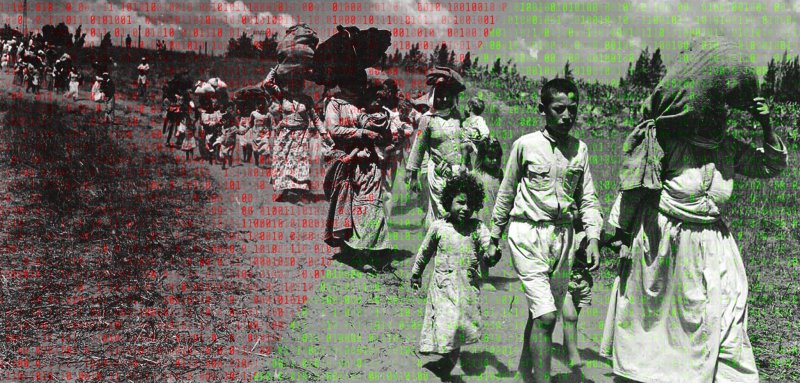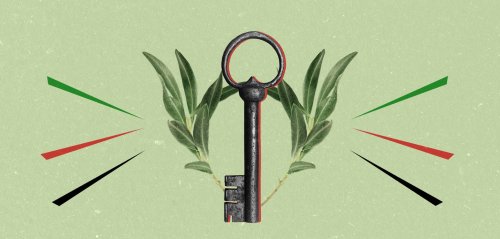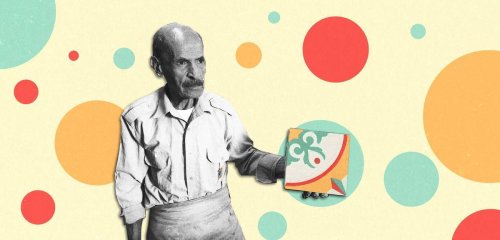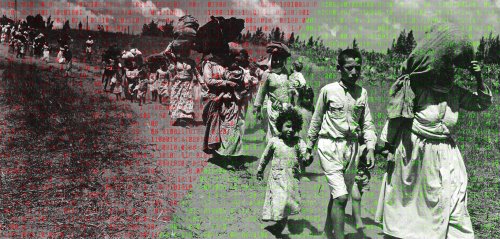Palestinian thinker Edward Said links the issue of power and the preservation of identity with the production of a compelling narrative. It may sometimes be based on the fabrication of legacy and the manipulation of specific joints from the past.
Said cited the Palestinian-Israeli conflict as an example of the Palestinians’ inability to build a historical narrative force that would rally people around a common goal, at a time when the concept of the “State of Israel” was based on the narrative of “the promised Zionist dream”.
Said’s words came within the general framework of dialectic grand narratives. However, the debate today revolves around the employment of digital age technologies, the development of a basic structure to build a Palestinian narrative along with a source for its consolidation, and also about how to use artificial intelligence technologies and the internet in a more appropriate, advanced, and in-depth way for the current technological revolution. This is to reduce the digital and knowledge gap imposed by the Israeli occupation, which had begun structuring its Zionist narrative from the time before the Nakba all the way to the digital age, adapting to current technologies.
In light of their diaspora, Palestinians need to exploit the technological revolution to strengthen the collective force more than anyone else, in order to construct a narrative that is diverse, unique, and interconnected at the same time. Therefore, the Palestine Digital Activism Forum (PDAF) — organized by the 7amleh Center (Hamleh) or the Arab Center for the Management of Social Media — raised ideas related to the digitization of the Palestinian memory. It also went into a related context of building a Palestinian narrative and its relationship to digitizing memory and history within a historical, social, and cultural context — in order to embody a relationship between the Palestinian refugees in diaspora and the place they and their grandparents left for more than 72 years. Thus, the question was raised about how to use this relationship to embody a state of rapprochement, preserve memory, and establish a unified Palestinian narrative in front of the world view in light of the revolution of social media and artificial intelligence.
There is not one single Palestinian narrative, due to the changing circumstances, eras, geography, social backgrounds, and the nature of life
How Palestine is Digitally Told
Eyad Barghuthy — a member of the “Untold Palestine” initiative and one of the participants in the dialogue session entitled “Palestinian Narrative in the Digital Age” — says that “heritage narratives journey from the past to the present through scattered texts, and via different means. It has also moved in various geographical fields of cultures and during different times — each with its own specific circumstances — until it finally reached us in its varying forms without affecting its content when it comes to culture and identity.” Barghuthy believes that “there is not one singular Palestinian narrative, due to the changing circumstances, eras, geography, social backgrounds, and nature of life among other elements. But they are all similar and carry the same content with the simple and direct truth.”
He continues, “But all of these narratives must be published as stories on digital media within the general framework of the Palestinian identity. Utilizing this digital space to shed light on new stories and narratives that have not been talked about before, would firstly build a solid Palestinian narrative, and secondly, remove the negative stereotypes about Palestinians and their cause vis-à-vis other groups and peoples. In the ‘Untold Palestine’ campaign, we use modern digital media and theories to highlight different stories that have not been told before — all within a unified framework of the Palestinian identity in a way that fits into the digital age and attracts the recipient.”
Omar Baddar of the Institute for Middle East Understanding (IMEU) addresses social media platforms and digital space as an opportunity to spread the Palestinian narrative along with untold Palestinian stories in international media, where the Israeli narrative dominates. Baddar, who had participated in the same session, points out that “the digital age offers us — as Palestinians — the opportunity to fix the negative image that the international media has created about Palestinians. This can be done by broadcasting the Palestinian narrative through the Palestinians themselves and not the way it is broadcasted by the international media which is biased towards Israel.”
Baddar says, “Today, the digital age and media have allowed us to use new tools such as animation and interactive videos in order to put the Palestinian cause on the map, especially for people who do not know anything about Palestine and how its historical events developed. They need information and data that reach them through persuasive tools that help them form an objective opinion over the conflict between Israel and Palestine.” Baddar believes that the United States supports Israel with billions of dollars annually in order to absent or erase the Palestinian narrative by exploiting the digital age.
The digital age offers us - Palestinians - the opportunity to fix the negative image that the international media has created about us, by broadcasting the Palestinian narrative through the words of Palestinians
Digitizing the Archive in the Face of Zionist Propaganda
For his part, Dr. Salim Abu Zahir, director and editor of the Palestinian Museum Digital Archive (PMDA) project at the Palestinian Museum — in another session organized by the platform under the title “Digitizing Palestinian History and Memory” — indicated that the museum has documented more than 200,000 documents digitally since 2018. The digital documentation came as part of a strategic initiative contributing to the production of alternative narratives about Palestine, its culture, and society with a new perspective that reinforces an inclusive national identity and consecrates the interdependence of Palestinians with one another.
He added, “These documents or digitized elements are distributed on a number of axes that cover all aspects of social history within a Palestinian context — such as social life, migration, and asylum — over more than two centuries. This is all done within the context of the categorical rejection of any attempts related to the falsification and reshaping of the narrative’s scenery by excluding the Palestinian narrative. The Palestinian Museum Digital Archive Project looks forward to continuing the journey of searching for Palestinian archives that are endangered and under threat of disappearing, to digitize them, preserve them and make them available for future generations.
In the same session, Laura Albast, digital content editor at the Institute for Palestine Studies, spoke of the importance of digitization with regard to the Palestinian issue in preserving the Palestinian narrative in the face of Zionist propaganda, and also preserving the Palestinian historical memory for future generations. She says, “We protect the archive, which consists of materials, photos, documents, records, and discs from damage, confiscation and theft,” stressing that, “Palestinians are quite vulnerable to digital theft.” Albast spoke about the “The Interactive Timeline of the Palestine Question” project, launched by the Institute for Palestine Studies in partnership with the Palestinian Museum. The project tracks and highlights the most prominent events in the modern history of Palestine from the end of the Ottoman era to the present time.
This is How Palestine is Brought Off the Map
The Palestine Open Maps Platform is a Palestinian project that uses open source techniques and ancient maps dating back to the nineteenth century in order to display Palestinian villages and cities alongside their original names in the Arabic language, as well as to compare the changes that have taken place as a result of colonialism and occupation.
Majd al-Shihabi, one of the people in charge of this project, participated in the “Digitizing Palestinian History and Memory” session. He says that “the project is not a static or rigid one. Rather, it allows those interacting with it through the ‘Mapa Phone’ to produce information and a database that will definitely be useful for future knowledge.” He adds, “The production and reproduction of knowledge by young Palestinians will change their understanding of Palestine and the situation the occupied land as a whole is experiencing today — through their understanding of its history.” The goal of the Palestine Open Maps Platform project, according to al-Shihabi, is to open these maps and make them available in a smooth, easy, user-friendly, useful, and reusable way to the public.
The production and reproduction of knowledge by young Palestinians will change their understanding of Palestine and the situation the occupied land is in today
“Palestine VR” (or Palestine Virtual Reality) is another Palestinian digital project that aims to connect millions of Palestinians from the diaspora to the towns and villages of their ancestors, also connecting them to the virtual simulation of the suffering that resulted from the occupation’s policies against Palestinians in their homeland. During her participation in a panel discussion within the Palestine Digital Forum under the title “Documenting Occupation Digitally: Palestine Virtual Reality (VR)”, Mayss Al Alami, the project trainer says that “Palestine VR” is a free app. It is a new tool that offers virtual tours in Palestine to the Palestinians who cannot visit their home country.” She continues, “We want to share Palestine with them and help them feel this place and understand it.”
This application, according to Alami, depicts people who live within the local Palestinian communities talking about Israeli violations and the robbery of Arab sites, so that the viewer can observe and interact with the location, as well as see its details in the way he/she wants and from all possible angles. Al Alami points out that one of the goals of this project is to make the produced materials available for use during any symposium, conference, or community activity that may serve the Palestinian cause.
“This application roams throughout selected cities in Palestine to display the ways the occupation and apartheid appear — both geographically and physically — and to provide the audience with the ability to take off on virtual tours of Palestine by themselves and share them with their communities in order to raise awareness. Many violations could be highlighted through this tool, perhaps the most important of which include settlement, water theft, the confiscation of land, among many others.” Al Alami says, “What distinguishes this project is that the Palestinians themselves — who have continued to suffer from the day they were born in the area — talk about the violations that happen on the ground, from the heart of the action, and in picture.”
The “Palestine Digital Forum” has shed light on many Palestinian digital projects, some of which aim to build a huge digital archive for the social history of Palestine, while others seek to employ its ideas in the network to connect Palestinians all over the world to their homeland, confirm their right to the land, and document Zionist crimes. These projects draw attention to modern digital technologies and how information and data can be summarized into useful information, and then transformed into knowledge when it comes to historical patterns and future trends.
Raseef22 is a not for profit entity. Our focus is on quality journalism. Every contribution to the NasRaseef membership goes directly towards journalism production. We stand independent, not accepting corporate sponsorships, sponsored content or political funding.
Support our mission to keep Raseef22 available to all readers by clicking here!
Interested in writing with us? Check our pitch process here!









